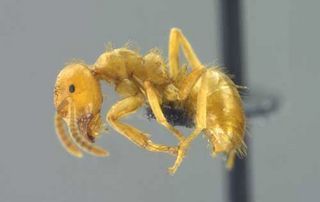Large Yellow Ant
Category: Ants

Facts about Large Yellow Ants, "Scientific name for Large Yellow Ants is Acanthomyops interjectus". Also known as "Citronella Ant" or "Foundation Ant". Large yellow ants, as their name suggests, are yellow ants measuring approximately ¼ inch (7mm) long and they are yellow. The Large Yellow Ants are also called citronella, because of the lemony scent they produce especially when they are crushed.
The Large Yellow Ants are not often easily seen outside during the day. They primarily forage at night and remain inactive during the day.
The Large Yellow Ants ranges throughout the western United States, in open woodlands, meadows woodland edges, meadows.
When there is heave rain spells in late June and early July, the Large Yellow Ants will build a temporary mound of excavated soil resembling mole hills (but much more precise in its construction), built up among dirt, clumps of grass or small stem. Tunnels are all through the soil around this temporary nest. The chambers in side this nest underneath the ground have exposed roots, and these have aphids-(a minute bug that feeds by sucking sap from plants and roots. It reproduces rapidly, often producing live young without mating, and may live in large colonies that cause extensive damage to crops).
In some areas where there is a high water table, this may be a permanent home and will have live vegetation growing from it and the aphid under the ground. The aphids excrete a sweet liquid that is called honeydew that the ants will gathered. It seems like the Honeydew provides the Large Yellow Ants with there primary source of nutrients.
Large yellow ants are underground in nature and it is not common to see the workers looking for food in human houses and other buildings. The Large Yellow Ants enter buildings during the middle of spring. They normally enter the House through cracks in the foundation plate or pipelines which pass through the subsoil. The sudden appearance of hundreds of the Large Yellow Ants tends to embarrass the home owners. The large yellow ants have the characteristic smell of citronella which gets strong when they are crushed in the dwelling. Large yellow ants nest are usually in areas of high humidity. The Large Yellow Ants usually nest on the ground outside of dwellings and they tend to build their nests under rocks or logs and form its galleries in the basement. Yellow ants are located close to the foundations of the houses. If the colonies are under concrete block, the Large Yellow Ants push earth through the cracks in the concrete when they are excavating in the underground galleries. When the floor of the basement starts to crack, homeowners usually feel anguish because they see it as an index of termite activity.
Indoors, the Large Yellow Ants nest inside wood rotted by fungi. The Large Yellow Ants tend to find wood rotting near openings where there are pipes, such as in bathrooms. Sometimes the large yellow ants build nests inside walls where there are leaks. There are cases in which colonies of yellow ants are located in wet areas, in confined spaces.
The mating occurs between the month of April and August. Large yellow ants are inactive during the day and so the mating only takes place at night. Just like many ants species, the large yellow ants take the nuptial flight. The winged females and males fly out and mate. Soon after mating, the winged Large Yellow Ants male dies because it is unable to feed. The female large yellow ants then move out to establish a new nest where it lays eggs. The eggs hatch to produce new workers, and winged females and males called swarmers. She takes care of the brood until the workers are able to forage and take care of the new colony. The swarmers also fly out of the nest and mate and the cycle continues.
Ants are omnivores like humans, an omnivores, (definition-they eat both other animals and plants).
Ants have two stomachs, one that holds food for them to eat and one for other the colony.

 Back To Category Ants
Back To Category Ants